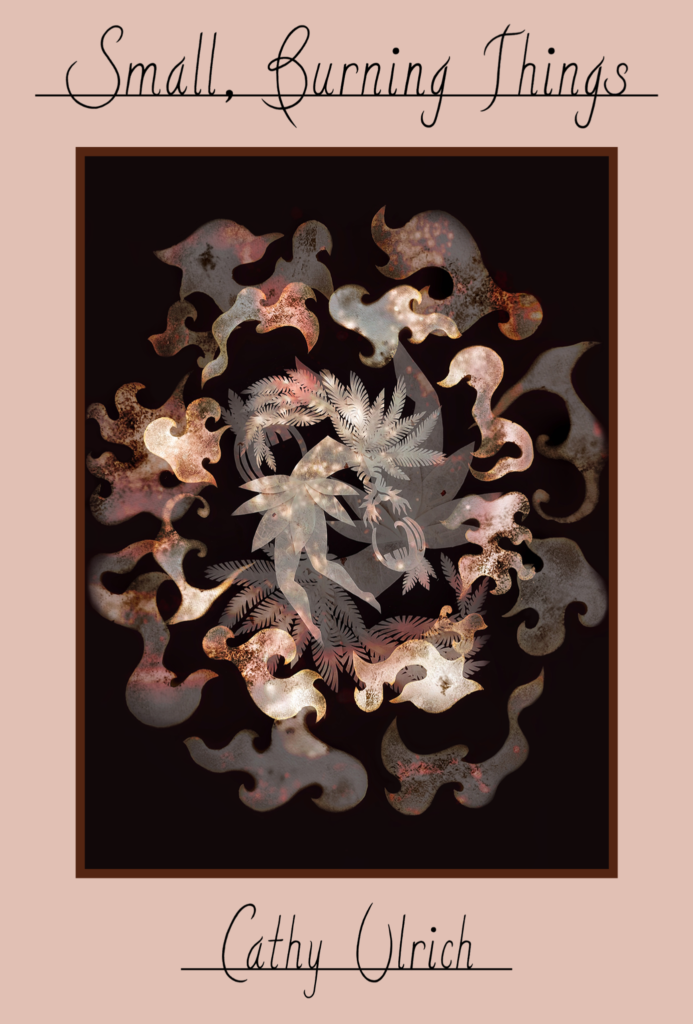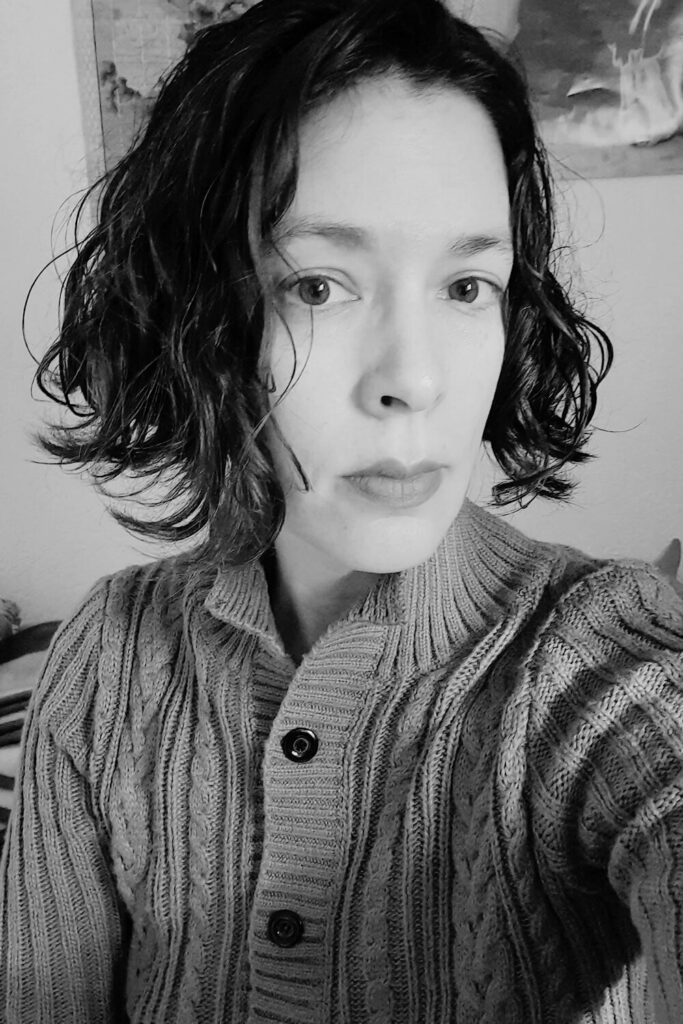By Charlotte Hamrick
Cathy Ulrich is a well-known name in the Flash Fiction world whose debut collection, Ghosts of You, was released by Okay Donkey Press in 2019 to rave reviews. Her latest collection, Small Burning Things, was recently released by Okay Donkey to the delight of her many fans. I talked to Cathy about her new book, her writing inspirations, and what might come next.

What perspectives or beliefs have you challenged with this work?
This is a tough one, because, unlike with my first collection, there isn’t any specific agenda with these stories. Sure, I’m writing mostly about girls and women, but it wasn’t with the intent to challenge anything. It was more like — this is what I’m focusing on, this is what I’m telling you about. Maybe it challenges someone’s perspectives. Maybe it doesn’t.
To tell you the truth, I’d actually love to see what other people might think. Did I challenge their perspectives and beliefs? I guess the answer is I really don’t know!
Talk about the relationship between personal experience and imagination in your writing.
In this book, I’ve got a story called “Wobble of Ostriches.” It was inspired by a kind of silly incident. As I was driving my daughter to her piano lesson, I glimpsed something out of the corner of my eye that looked like an ostrich. (Note: it was not an ostrich.) (Additional note: or an emu.)
I said to my daughter: “Is that an ostrich?”
Then I said: “I should write a story about someone fighting an ostrich.” (Note: no one actually fights an ostrich in the story, but this was my thought at the time. My daughter’s thought was “why is my mom going on about ostriches all of a sudden?”)
So there was a little bit of personal experience (me thinking I saw an ostrich) and a whole lot of imagination (literally everything else in the story) at work there.
And that’s the same with a lot of my stories. There might be something that happens that inspires me to write a story, something real, but there’s a whole lot of “and then what if someone gave the girl A ROBOT ARM?”
I love that a chance sighting like that ends up in a story. That’s great. “Like Doll Parts” with the robot arm is pretty amazing. I feel like it’s a story about losing oneself, maybe in substance abuse or a relationship or through not “being seen” – was that your intention or was it purely extrapolating on your original thought “what if”? Which brings us back to your previous comment about challenging the reader’s perspective or beliefs. For me, that story made me wonder what compels us to continue with behavior that is clearly not good for us. It made me think!
See? I love that! I definitely had no thoughts of that while I was writing this story — for me, it was about a girl making some very iffy decisions, but they are hers and give her a kind of freedom and power that she had previously been missing. And I love that people might look at it as “losing oneself,” which, yes! She does kind of (literally) lose herself, doesn’t she? But I think she really does gain something too.
Which of the characters do you relate to the most and why?
Oh, it really depends on the story and how I felt at the time. A lot of these stories were sparked by an emotion, which sparked an idea, which sparked a sentence, which sparked a voice, which … well, etc.! But while I was writing them, each of these characters felt really real and relatable to me.
I think the character I relate to the least is the mother in “Maybe in the Clouds, Maybe in the Stars,” because how could she do that to her children? But I hope that in writing her story, I can give a little glimpse into what it would be like to be in her position.
Yes, that story is disturbing but when I read it I kept thinking of postpartum depression and how we see over and over again women doing harm to their children. It makes me sad that obviously these women needed psychiatric help but didn’t get it. The children suffer and the mother usually ends up in prison.
Missing and dying children are a recurrent theme. Why do you think that is?
I was very lucky when my daughter was born — I was exhausted and overwhelmed and didn’t know what the hell I was doing, but, oddly enough, I was actually a lot less depressed than usual. So I feel very lucky that I had that experience.
As far as the theme of missing and dying children — well! I will just say that my full-time job is at a funeral home, and I have seen a lot of sad things. And it’s definitely something I think about often. My daughter is the most precious person in my world. I would be utterly broken if anything happened to her.
Which story did you have the hardest time writing?
That would probably be “The Falling Girls.” The beginning and the middle weren’t hard at all (I had that image of Mary Song in her wedding dress, Mary Song with her long black hair, Mary Song wanting her story told), but I kept fudging the ending for months.
I kept wanting to wrap things up too cleanly, drag it out too long.
And I struggled with it for a while — I think I had a rough draft of this story hanging around for several months before I finally realized hey, that section where everyone’s passing around a note? That’s the ending!
“The Falling Girls” and “Storm Girls” both have the falling theme. The girls in both stories fall to their deaths or are damaged physically. “Storm Girls” especially caught my attention because how do you think up a storm of girls?
Oh, gosh, I wish I could remember! That’s one of the older ones, unfortunately, and I’m sure my thought process was like “what if it was raining girls instead of men?”, but I truly can’t remember. I do know that I really wanted to focus on the sensationalist aspect of it — the way these girls were focused on as if they were celebrities, as if they had sought this out. Hopefully that comes across!
If you were to write a spin-off about a side character, which would you pick?
Hmmmm … probably the girl in “Baxter’s Girl”? I guess technically she’s not a side character since the story is named after her, but she doesn’t really get a voice (or much of anything!) in the story. I’ve always wondered how she got where she was — I actually tried writing about her a few times, but she’s remained a real mystery to me so far.
Well, sometimes mysteries are better left mysteries but I’d love to see a follow up to that one!
We’ll have to see!
One of my favorites is “Through the Veil of Her Hair” because I’m fascinated by ghost weddings in some provinces of China that are even still practiced. Was that the spark for this story?
Oh! This one I actually remember — I was reading an advice column and someone was like “my former fiancée’s family wants me to have a ghost wedding. What should I do?” And I was like “a ghost wedding? What is this about ghost weddings?” So I went down this rabbit hole of researching ghost weddings and came up with these characters. I remember the person in the advice column didn’t particularly want to do it (they thought it was kind of creepy), but the narrator here, I think, is just grateful for this chance to be with the woman she loves — no matter how.
Cathy, I was familiar with most of the stories in this collection, having read your work for years. How many years of writing are represented in this book?
Probably about six? I believe it spans from 2015 to early 2022 … so let’s try that math again! Probably about seven years. These aren’t in order from earliest written to latest written; they’re all jumbled up. But I think almost every year of my flash writing career is sampled here.
Who are your biggest influences?
There’s far too many to name! Have you seen the amazing flash fiction that’s being produced? It’s such a wonderful time for the medium, and I’m so glad there are so many beautiful things for me to read!
That said, I will give a few names of some amazing writers who inspire me: Exodus Oktavia Brownlow, for one. You can really feel her soul in her stories. Candace Hartsuyker — she has such a powerful imagination and beautiful writing style. Sarah Freligh, Kathryn Kulpa, Avitus Carle — oh, you see one of their names on a piece of writing and you know you are in for something special.
I agree! All of them are writers whose work I look out for.
There are so many amazing flash writers out there. It’s wonderful to see all this beautiful work.
What is the most valuable piece of advice you’ve been given about writing?
“Write what you know.”
I know that a lot of people really despise this piece of advice, but I feel like some people take it too literally, too specifically, like it means “write only what you personally have experienced.” I don’t look at it like that; I look at it as coming from a place of my knowledge. Sure, it could start with something I have experienced. It could come from something I’ve read about, or watched on TV. I don’t have to personally experience something to know it. But have that understanding in your writing, using those details that do come from your experience, your knowledge — I think that gives your writing a special flavor that only you can give it. Writing what you know makes your story unique to you.
What are your plans for the future? Might there be an astronaut-themed book? Maybe even a novella? Your astronaut stories are my favorites!
I love the astronaut and her wife, but I don’t feel like their story is quite done yet. So I’m not ready to gather everything up into a collection. Maybe someday soon! And thank you!
Cathy, it’s been pure pleasure talking with you! Where can readers purchase Small Burning Things?
Thank you, Charlotte!
And you can order it directly from the publisher: Okay Donkey Books.

Cathy Ulrich
Cathy Ulrich is the founding editor of Milk Candy Review, a journal of flash fiction. Her work has been published in various journals, including Black Warrior Review, Passages North, and Wigleaf and can be found in editions of Best Microfiction, Best Small Fictions, Best of the Net and Wigleaf‘s Top 50 Very Short Fictions. She lives in Montana with her cat, who is, perhaps, not as small as you might have been led to believe.

Charlotte Hamrick
Charlotte Hamrick’s creative writing and photography has been published in a number of literary journals and anthologies including Still: The Journal, The Citron Review, Atticus Review, Reckon Review, Trampset, and New World Writing, among many others. Her fiction was selected for the Best Small Fictions 2022 anthology and she’s had several literary nominations including the Pushcart Prize, Best of the Net, Best Small Fictions, and Best Microfiction. She is the former Creative Nonfiction Editor for Barren Magazine and current Creative Nonfiction Editor for The Citron Review. She also writes intermittently on her Substack, The Hidden Hour. She lives in New Orleans with her husband and a menagerie of rescued pets where she sometimes does things other than read and write.
